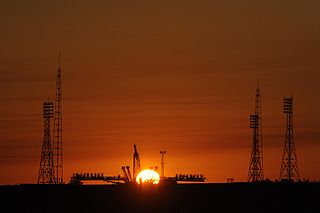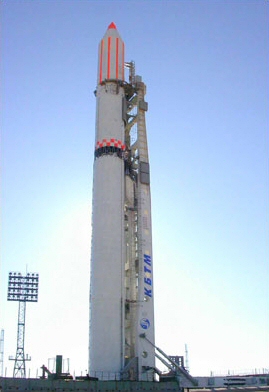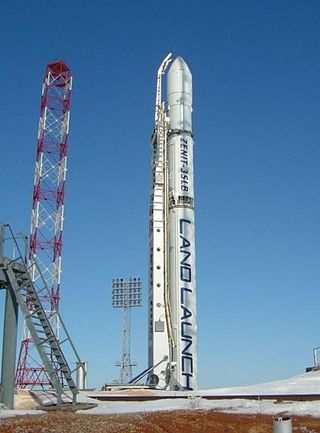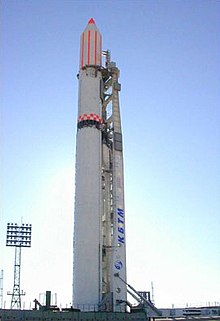Energia was a 1980s super-heavy lift launch vehicle. It was designed by NPO Energia of the Soviet Union as part of the Buran program for a variety of payloads including the Buran spacecraft. Control system main developer enterprise was the Khartron NPO "Electropribor". The Energia used four strap-on boosters each powered by a four-chamber RD-170 engine burning kerosene/LOX, and a central core stage with four single-chamber RD-0120 (11D122) engines fueled by liquid hydrogen/LOX.

The Baikonur Cosmodrome is a spaceport in an area of southern Kazakhstan leased to Russia. The Cosmodrome is the world's first spaceport for orbital and human launches and the largest operational space launch facility. All crewed Russian spaceflights are launched from Baikonur.

Zenit is a family of space launch vehicles designed by the Yuzhnoye Design Bureau in Dnipro, Ukraine, which was then part of the Soviet Union. Zenit was originally built in the 1980s for two purposes: as a liquid rocket booster for the Energia rocket and, equipped with a second stage, as a stand-alone middle-weight launcher with a payload greater than the 7 tonnes of the Soyuz but smaller than the 20 tonnes payload of the Proton. The last rocket family developed in the USSR, the Zenit was intended as an eventual replacement for the dated Soyuz and Proton families, and it would employ propellants which were safer and less toxic than the Proton's nitrogen tetroxide/UDMH mix. Zenit was planned to take over crewed spaceship launches from Soyuz, but these plans were abandoned after the dissolution of the Soviet Union in 1991.

The Angara rocket family is a family of launch vehicles being developed by the Moscow-based Khrunichev State Research and Production Space Center. The launch vehicles are to put between 3,800 kg (8,400 lb) and 24,500 kg (54,000 lb) into low Earth orbit and are intended, along with Soyuz-2 variants, to replace several existing launch vehicles.
The Zenit-2M, Zenit-2SB, Zenit-2SLB or Zenit-2FG was a Ukrainian expendable carrier rocket derived from the Zenit-3SL. It was a member of the Zenit family of rockets, which were designed by the Yuzhmash.

This article outlines notable events occurring in 2005 in spaceflight, including major launches and EVAs. 2005 saw Iran launch its first satellite.

The Zenit-2 is a Ukrainian, previously Soviet, expendable carrier rocket. First flown in 1985, it has been launched 37 times, with 6 failures. It is a member of the Zenit family of rockets and was designed by the Yuzhmash.

Gagarin's Start, also known as Baikonur Site 1 or Site 1/5 is a launch site at Baikonur Cosmodrome in Kazakhstan that was used for the Soviet space program and is now managed by Roscosmos.

Site 200 at the Baikonur Cosmodrome is a launch site used by Proton rockets. It consists of two launch pads, areas 39 and 40. Area 39 is currently used for Proton-M launches, including commercial flights conducted by International Launch Services. Area 40 is currently inactive, as it was slated to be rebuilt as a launch site for the Angara rocket. Although the project was relocated to Site 250, Area 40 was not put back into service.

Site 81 at the Baikonur Cosmodrome is a launch site used, along with Site 200, by Proton rockets. It consists of two launch pads, areas 23 and 24. Area 24 is used for Proton-K and Proton-M launches, while Area 23 is inactive.

Launch Pad 0 (LP-0), also known as Launch Complex 0 (LC-0), or Launch Area 0 (LA-0), is a launch complex at the Mid-Atlantic Regional Spaceport (MARS) on Wallops Island, Virginia, in the United States. MARS is located adjacent to NASA's Wallops Flight Facility (WFF), which ran the launch complex until 2003. WFF continues to provide various support services to MARS launches under contract with the Commonwealth of Virginia.
Site 133, also known as Raduga, is a launch complex at the Plesetsk Cosmodrome in Russia. It is used by Rockot, and previously Kosmos carrier rockets. It consists of a single pad, originally designated 133/1, and later 133/3.
Site 41, also known as Lesobaza and SK-1, was a launch complex at the Plesetsk Cosmodrome in Russia. It consisted of a single pad, Site 41/1, and was used by R-7 derived rockets between 1959 and 1989.

The Zenit 3SLB or Zenit-3M is a Ukrainian expendable carrier rocket derived from the Zenit-2SB. It is a member of the Zenit family of rockets, which were designed by the Yuzhnoye Design Office. Produced at Yuzhmash, the rocket is a modified version of the Zenit-3SL, designed to be launched from a conventional launch pad rather than the Sea Launch Ocean Odyssey platform. Most of components of the rocket are produced in Russia.
The Vostok-2M, GRAU index 8A92M was an expendable carrier rocket used by the Soviet Union between 1964 and 1991. Ninety-three were launched, of which one failed. Another was destroyed before launch. It was originally built as a specialised version of the earlier Vostok-2, for injecting lighter payloads into higher sun-synchronous orbits. It was a member of the R-7 family of rockets, and the last Vostok.

Launch Complex 18 (LC-18) is a launch complex at the Cape Canaveral Space Force Station, Florida that was active during the late 1950s and early 1960s. It was used by Viking, Vanguard, Thor and Scout rockets. The complex consists of two launch pads, LC-18A, which was originally built by the US Navy for the Vanguard rocket, and LC-18B, which was originally by the US Air Force used for tests of the PGM-17 Thor missile.

Elektro–L is a series of meteorological satellites developed for the Russian Federal Space Agency by NPO Lavochkin. The first satellite, Elektro-L No.1, was launched on 2 January 2011. It is the first Russian weather satellite that successfully operates in geostationary orbit, and is currently the second operational Russian weather satellite. The satellites have a mass of about 1620 kg and are designed to operate for 10 years each. They are capable of producing images of the Earth's whole hemisphere in both visible and infrared frequencies, providing data for climate change and ocean monitoring in addition to their primary weather forecasting role.
Site 110 at the Baikonur Cosmodrome is a launch facility which was used by the N1 rocket during the late 1960s and early 1970s, and by the Energia rocket during the 1980s.
Site 35 at the Plesetsk Cosmodrome is a launch complex used by Russia's Angara rocket. The complex has a single launch pad, Site 35/1, which was first used for the maiden flight of the Angara in July 2014.

Irtysh, also named Soyuz-5, formerly codenamed Fenix in Russian and Sunkar in Kazakh, is a planned Russian rocket that is being developed by JSC SRC Progress within the "Project Feniks". Initially it will replace the capability of Zenit-2 and Proton Medium, and in the future will serve as the base of a super heavy-lift launch vehicle rocket (Yenisei) to match the Energia/Buran capabilities. As of February 2021, Irtysh is expected to launch from the Baikonur Baiterek, the ex Zenit-2 launch site, in a partnership with the government of Kazakhstan, with a planned debut in 2024.













